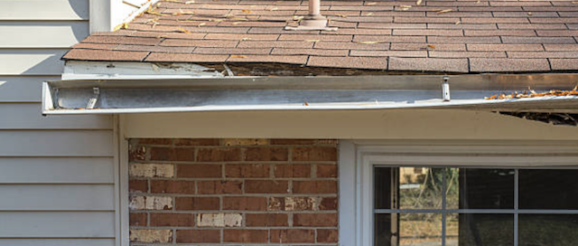7 Signs of Gutter Damage on Your Home

If you are like a lot of homeowners, your gutters aren’t something you often think about. They need biannual gutter cleaning, but besides that, their functionality is very simple.
It’s not until gutters aren’t doing what they’re supposed to that you understand just how important they are!
WHAT DO GUTTERS DO?
Gutters and downspouts go unnoticed on most roofs in Washington. They blend into the home’s exterior unless the homeowner preferred copper or wood … building materials that are definitely meant to stand out! Most home exteriors are made of durable yet lightweight aluminum or vinyl siding.
The point of rain gutters is to provide a route of minimal resistance for rain to get off your roof. When they are in good condition, your rain gutters will lead runoff away from the foundation and landscaping, protecting your home’s exterior from mildew and mold, the concrete and pavement and basement from leaking water, and the gutters themselves from rust.
When they are damaged, it can cause thousands of dollars’ worth of damage to your home and property.
ARE YOUR GUTTERS DAMAGED?
Gutter damage is too simple to fix to be the cause of major home repairs! Inspecting your gutters is simple and safe. If you see any of the following issues, it’s a good indication that your gutters have some type of damage.
As soon as you notice a possible gutter issue, you can decide if it’s something you are comfortable fixing or remedying by yourself or if it’s a project you’d rather call a gutter company for.
Sitting Water Near Your Home
Standing water near your home is a sure sign that your gutters or downspouts are not directing the rain runoff away from your home the way they are designed to. Standing water can result in mold, weakening of your foundation, and provides the perfect habitat for pesky mosquitoes. Plus, it will make the areas surrounding your home consistently soggy and muddy.
Mold or Mildew
Mold or mildew is a bad sign, whether you see mold or mildew on the gutters or the sides of your house. Mold and mildew indicate there is too much moisture around that area – a potential problem with the gutters could be the cause. Remember that mildew and mold are more likely to grow on the north side of a house anyway, so if that’s where they’re appearing, it might just be because that area gets very little direct sunlight. This is a situation where the advice and expertise of a professional in Washington would be a great help.
Rain Pouring Over the Gutter
You will need to wait until it’s actually raining to notice this type of gutter issue. Hopefully this doesn’t mean that you have gutter damage. It could just be that the gutter is full of debris and needs to be cleaned out. Either way, you want to have it checked ASAP.
Basement Leaks
Depending on the construction of your basement, your leak could be due to any number of things. The standing water problem we discussed earlier could definitely lead to a basement leak. Egress windows and cinder block walls can only block out so much water. That’s why it is important to keep your gutters in good shape!
Landscaping or Lawn Damage
Gutters pour directly onto the ground most of the time, and landscaping should be laid out to work with this water flow to help it disperse into the ground. But, a gutter leak or clogged gutter will allow rainfall to overflow or pool in areas where it shouldn’t. This pooling water can destroy plants either by force or by overwatering. It can also displace flower bed materials like mulch or rock.
Water Marks
Water marks are the first sign that there is a lot of moisture on a surface. Water marks are sometimes left behind even if standing water has evaporated or dissipated into the ground. You usually find water marks right under the rain gutters or behind the downspouts. This is a usually a sign that rain water is pouring down the outside of the gutters and not staying inside of them.
Visible Gutter Damage
The last sign of gutter damage is the easiest to spot. If your gutters are bent, sagging or cracked, they definitely have damage. After a storm, it’s a smart idea to walk around your home to assess any damage to the roof, outer walls, and gutters. These inspections are in addition to any routine home inspections.
HOW TO PROTECT YOUR GUTTERS?
Here are a few easy ways DC Gutter Service recommends to prevent gutter damage:
Clean your gutters out at least once each year. You can lengthen the amount of time between gutter repairs by having them cleaned out. Like with anything else, the better you care for your rain gutters, the less problems you’ll have with them.
The optimal time to clean gutters is in the spring, but to be extra cautious, give them a cleaning in the fall, too. A lot of homeowners clean their gutters themselves, but there are many local gutter cleaning companies that offer this service so you don’t have to handle the work or the risk.
Check your gutters often. Signs of damage can be visible from the outside of the gutters. A quick inspection – with both feet firmly on the ground – should reveal any of the issues we wrote about above.
We’d recommend that you do an exterior home inspection at the end of each season to confirm that your gutters are functioning the right way.
When you see signs of gutter damage, act fast. Taking care of an issue before it becomes too bad can save you time and money. A small crack, for example, can be sealed, or the section of gutter with the crack can easily be replaced very affordably.
But, if you let the issue go on too long, you could end up making repairs in your basement, replacing vinyl siding or redoing an entire area of landscaping.
